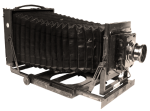Proper Media Storage and Preservation
Any medium upon which information
images or sound is recorded will in time deteriorate
some just deteriorate more quickly than others.
Though each method and media has advantages and disadvantages, a recording entrusted to a seemingly reliable media may degrade due to poor manufacturing method and materials used. Proper media storage and preservation practice is therefore mandatory to save your media history.
Film
Film in general can last very well and may even outlast video formats or optical recording mediums such as the compact disc and video DVD, that is as long as the original manufacturing process and storage method is sound. Kodachrome has a strong reputation for good colour rendition and longevity, but can fade more quickly than some other film types if exposed too frequently to the strong light source in a projector. Kodachrome is however regarded as a good archival medium. In other film brands often colour fade is the biggest problem.
Video
Different formats of video tape recording have different expected life spans. Soon after the release of VHS video cassette recorders it was recognised that the life expectancy of VHS tapes was probably not as good as previous professional tape formats. Just how much worse has always been open to debate, 10 years seems to be typical. Increasingly there is a need to recover many such recordings, since although some older tapes may still be playable it is evident that many have developed problems.
Photographs
Still photography also has come in for its share of longevity problems. Newer manufacturing processes of film and print material have run into problems entirely contrary to the claims of breakthrough improvements by manufactures. Many professional photographers in the 1980s suddenly started to receive complaints from former clients of the late 1960s and early 1970s of their prints fading badly, despite the fact that manufacturers claimed that this new process had far better quality and longer life than previous methods. Film and prints will eventually fade because the components used will break down in time. This is particularly so of the dyes used in colour film and prints.
Sound
In a similar manner, sound tape manufactures found too late that a change in formulation in about the 1960s resulted in many stored tape recordings suffering from sticky syndrome, where the binder used to glue the magnetic coating to the base material would be affected by humidity and the tape would shed a sticky goo onto the working parts of the tape recorder. Fortunately this problem can be reversed temporarily sufficient to recover the recording.
Archiving
It has been said that any material within which a recording is encoded or the base material used to support it will be always trying to revert to it’s original pre manufactured state. Some much more rapidly than others.
No medium and the recording it carries can be said to be invulnerable, but once a recording is recovered digital recording methods and media are our best defence against further loss. There are a number of things to remember when considering long term archiving of any visual or audible material. The basic guide is..
- make a good copy to the best and most stable medium available
- store the copy and original in a way that preserves stability of the medium and
- make multiple digital copies to be stored in different locations and in the possession of different persons.
Until a totally reliable archive method is found these tactics will provide the best chance of preserving memories of the past, for the future.


